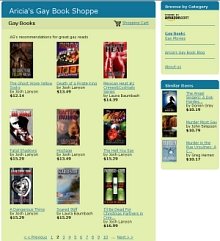Small town romance ... gay style!
 One of the best questions you can ask yourself would have to be this: "As a concerned and helpful adult, when you know a kid is growing up gay, what books would you recommend for him/her to read by the time he or she gets to maybe 14 or 15, and deserves to be treated like an intelligent person who knows where his/her sexual orientaties lies?"
One of the best questions you can ask yourself would have to be this: "As a concerned and helpful adult, when you know a kid is growing up gay, what books would you recommend for him/her to read by the time he or she gets to maybe 14 or 15, and deserves to be treated like an intelligent person who knows where his/her sexual orientaties lies?"
It's not an easy question to answer. You have to choose books that have something positive to say ... but they have to say it in language that's suitable to somebody who's hovering between the PG and MA-15 audience.
If you were a writer, you'd probably find this was one of the hardest of all age brackets to aim for. Write too simply, and kids will chuck the book away for being childish (or even childlike). But step over some line that somebody drew in the sand, and you've written an adult book, not a "young adult" book.
I really don't think Patricia Nell Warren wrote The Fancy Dancer for a teen audience! There's no teeny-weeny stuff in it. No Prom night angst, and gym class jitters, and your basic schoolie plotting that kills teen books stone dead for anybody who's "put the high school campus to their rudder" with no intentions of ever going back there. In fact, Fancy... is about grown men, Real Life ... a gorgeous hunk called Vidal, and a young Catholic Priest, Father Tom ... and, oh yeah, about being gay.
It's been said that PNW wrote this as a "follow-up" to The Front Runner (I reviewed that one a while ago, here: http://ariciasgaybookblog.blogspot.com/2008/12/gay-edutainment-way-out-in-front.html), but I seriously doubt it. Fancy... has nothing whatever to do with the other book. The only two things they have in common are, 1) they have gay central characters, and 2) they were published by the mainstream press at a time when gay books were like hens' teeth. Rare. Some critic somewhere probably figured that for the same writer to write yet another gay book, it'd have to be a follow-up.
In fact, PNW was writing these books at the same time as Mary Renault was doing the Alexander books ... and both these authors were writing gay guys, and writing them well -- with a big BUT dangling off that sentence. Here it is: they were writing gay guys well, but they weren't allowed to write sex scenes that got even mildly spicy, because mainstream readers (publishers, editors, critics...) at the time would have thrown a hissy.
The Fancy Dancer was put out in 1976 by William Morrow, who took a bit of a risk on it because The Front Runner had been very successful. Yet, as a gay book -- well, it's a lovely little piece that's the gay equivalent of a Harlequin romance!
If you have a 14 or 15 y.o. kid who's growing up gay, and you wanted to give him a bunch of books that would help, not hurt or hinder, Fancy... would be in the list.
But the "teen rating" the book gets today is contextual. We rate movies and books for their crude language and nudity and explicit sex. If there ain't none of these goodies, the movie gets a PG. This is where rating gets pathetic. You can have a movie or a book that grapples with the most adult of adult content, but as long as it minds its language and doesn't show much skin, fine. (I can think of quite a few "old movies" that tell stories about rape, mutilation, slavery, terror, revenge, drunkenness, murder, lust, war ... but because they were made in the 1950s or 60s, they're not foul mouthed and full of nudity, so ... PG it is, even though an impressionable 9 y.o. could be scarred for life by the concepts expressed!)
And this is why The Fancy Dancer would be classified as a "gay Harlequin" today! The fact is, the book has a lot more to say about being human, being gay, being a hellraiser ... and a Catholic priest, and working to reconcile your spirituality with your sexuality.
When I read the book (I got the GMP reprint, about 1988 or 1990) I had a few reservations at first. I wasn't that keen to read a book about a priest! I have to tell the truth here: I have no vaguest interest in the church. I honestly don't. So I was amazed by how Patricia Nell Warren actually made a lot of the book interesting, when I'd expected to be skipping over 10-page-chunks. I think it's the way it's written that makes it interesting ... like The Da Vinci Code, sure, it's about the church in a way ... but it's more about the people in, and behind, the church.
The conflicts of interest, the clashes of ego, the arrogance of some, the ambition of others. This is what makes the book tick. Father Tom is a very young priest who's working in a little town in the Rocky Mountains. The location fascinated me at once. He's doing community work, and finds himself trying to drag a gorgeous half-caste Indian (Blackfoot) called Vidal back from the brink of self-destruction. The Native American aspect of the story was the second thing that got me interested. Cottonwood is an interesting town, with well-drawn characters, and Vidal is the most "living" of them all.
Turns out, Patricia Nell Warren is from Montana, so her depiction of the region is spot-on for those who live there, and very evocative for the folks who'd just like to visit. I often wonder if Vidal was based on someone she knew. He's very ... real. And he has even more to teach Father Tom than Tom has to teach him...
Because it turns out, Tom is gay as well as Catholic, and a priest to top it off. (You'd think it was an impossible, suicidal combination, but in fact there's a lot of gay priests. I don't actually understand what would inspire a gay boy to enter the priesthood, but -- hey, it's their lives to live, they know best.)
The story concerns the town, the people ... the priest and the tearaway gay Blackfoot dancer. It's a love story, and a good one. You like this book. You like the characters. For example, Vidal's parents -- his father, who is a cop, with a sharp sense of humor ... and the contrast between these people and Father Tom's parents.
When you finish The Fancy Dancer, it's going to be the characters you remember. And the fact that the book has a lot of good things to say -- about being human, and gay, even Christian, and a priest. And finding ways to be "good" in each one of those categories. No surprise that this book turned out to be a bestseller in hardback before it went into paperback!
Highly recommended, especially for teens. AG's rating: 5 out of 5 stars. Still in print, in something like the tenth edition...









0 comments:
Post a Comment